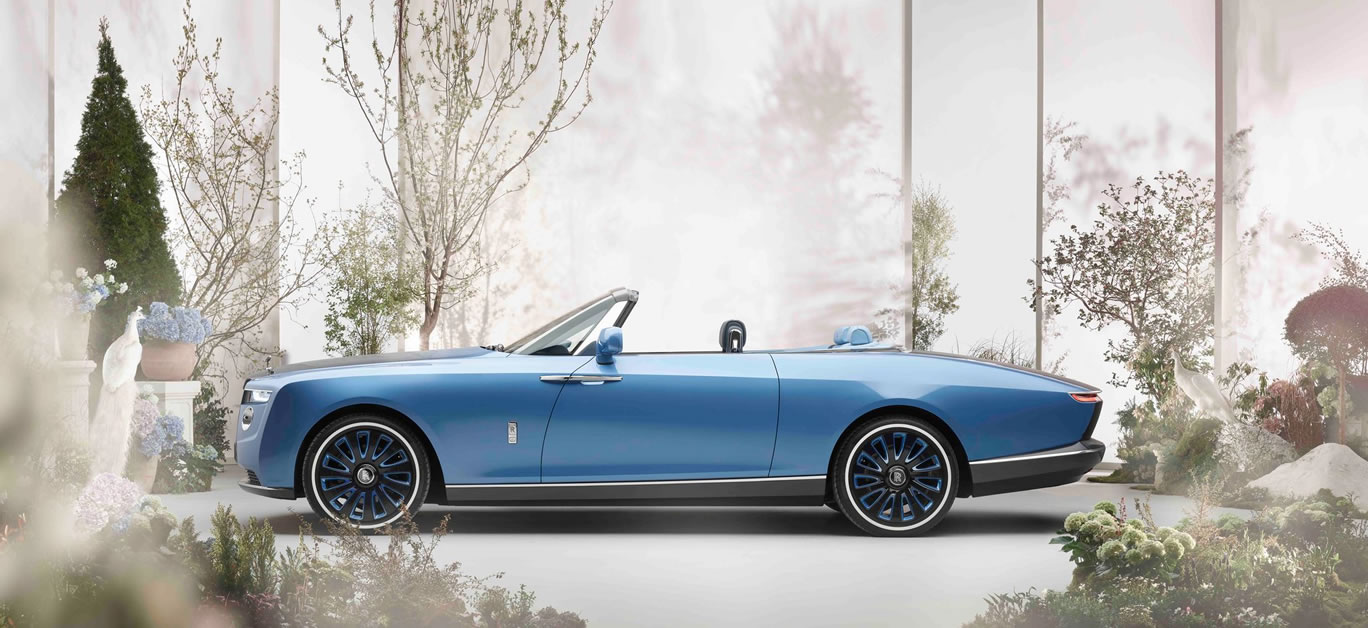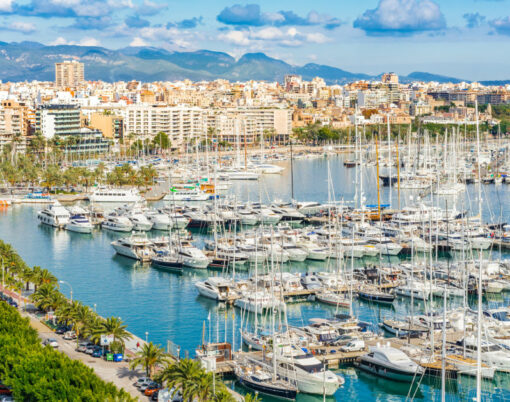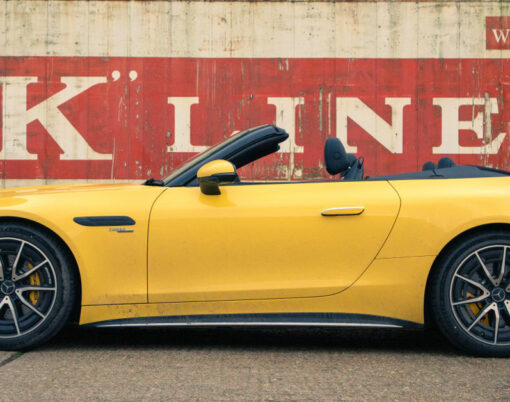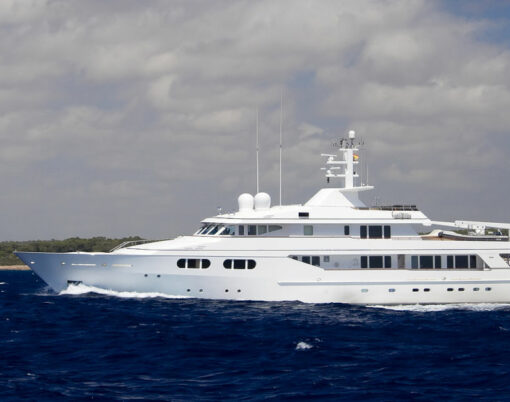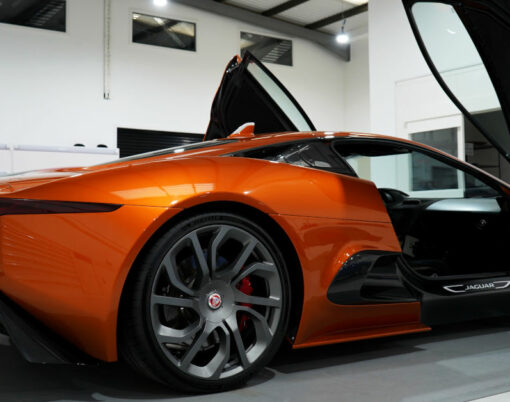“Rolls-Royce Boat Tail challenges the notion of what a motor car is and creates a new definition of what a motor car means. Boat Tail exists far beyond a mere means of transport. It is not just the method to reach a destination, but the destination itself. It is an ambition realised with a remarkable cohort of women and men who empowered the marque to create a concept of extraordinary scope.”
These are the words of Alex Innes, the head of Rolls-Royce Coachbuild Design and words which would be appreciated by Sir Henry Royce, one half of the legendary partnership that would establish Rolls-Royce as an icon of luxury motoring and form the foundations of a marque which over 115 years later remains a status symbol around the world, a representation of wealth and discernment, power and prestige, craftsmanship and luxury.
Sir Henry once said: “Strive for perfection in everything you do. Take the best that exists and make it better. If it doesn’t exist, create it. Accept nothing nearly right or good enough.” With the launch of Rolls-Royce Boat Tail, Rolls-Royce and its design and manufacturing team have created something that didn’t previously exist – they have crafted a new standard in luxury motoring and pushed the boundaries of what has been previously been feasible, displaying extraordinary levels of engineering capability and creation.
When talking of Boat Tail, Innes describes it as “imbued with the unique, highly personal imprint of the commissioning patron, thereby telling differing stories. Boat Tail is unprecedented. Boat Tail is a distinct counterpoint to industrialised luxury”.
The unveiling of Rolls-Royce Boat Tail launches ‘Rolls-Royce Coachbuild’, a new department within the renowned British car marque. As the epitome of luxury motoring, Rolls-Royce has always provided its clients with an ability to personalise their Rolls-Royce. However, Rolls-Royce Coachbuild will push this further, taking the concept of ‘Rolls-Royce Bespoke’ to a new level. Rolls-Royce Boat Tail encapsulates the concept of this new department with it representing a collaborative exploration of luxury, design and culture between the marque and its commissioning clients. Rolls-Royce Coachbuild will empower clients to “create potent evocative expressions of personal taste”.
On the launch of Rolls-Royce Boat Tail, chief executive Torsten Müller-Ötvös stated: “Today marks a seminal moment for the House of Rolls-Royce. We are proud to unveil Rolls-Royce Boat Tail to the world, and with it, the confirmation of coachbuilding as a permanent fixture within our future portfolio. Historically, coachbuilding had been an integral part of the Rolls-Royce story. In the contemporary Rolls-Royce narrative, it has informed our guiding philosophy of bespoke. But it is so much more. Rolls-Royce Coachbuild is a return to the very roots of our brand. It represents an opportunity for the select few to participate in the creation of utterly unique and truly personal commissions of future historical significance.”
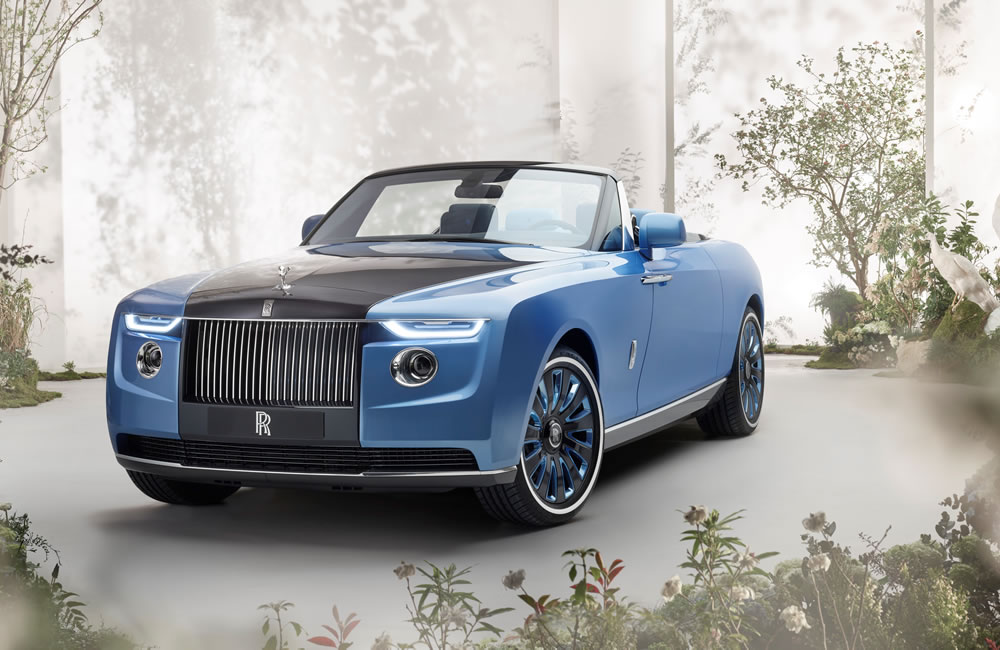
The chief executive continues: “Rolls-Royce has carefully listened to its closest clients, each of whom has expressed a desire to deepen their relationship with the brand by creating ambitious, personal statements of true luxury. Rolls-Royce Coachbuild clients are intimately and personally involved at each step of the creative and engineering process. We work in harmony with the client to gain complete fluency in the nuances of their character and personality. We carefully translate these qualities into the elements with which they wish to imbue their commission.
“Only the House of Rolls-Royce can offer its Coachbuild clients the inimitable opportunity to commission a product of future historical significance, that is as fundamentally unique as they are – and then participate in every detail of its creation.”
Mr Innes continues to explain how Coachbuild pushes the boundaries of what has been previously possible. “Coachbuild provides freedom to move beyond the usual constraints. Normally, there is a natural ceiling to Rolls-Royce Bespoke by way of the canvas. At Rolls-Royce Coachbuild we break through that ceiling, embracing the freedom of expression afforded by coachbuilding to shape a concept directly with our commissioning patrons.”
Inspired by the coachbuilding of the 1920s and 1930s, in 2017, the Rolls-Royce Sweptail was revealed, a one-off car, designed to the desires of its purchaser in conjunction with Rolls-Royce’s creative director. The Sweptail, with an alleged price tag in excess of $10 million, was reputed to be the most expensive new build car ever, and remains as one of the most visually arresting cars of all time.
Sweptail is a stunning contemporary luxury vehicle, with design nods to the beauty of Rolls-Royce cars of a bygone era, combined with design elements taken from classic and modern yachts. It was this release that started the internal movement at Rolls-Royce to enable clients to develop more personalised vehicles.
Coachbuilding has a rich heritage at Rolls-Royce. Back in the early to mid 1900s, it remained only the engine and chassis that were made by Rolls-Royce, with the body of the vehicles supplied by a select number of coachbuilders, the most well known for Rolls-Royce being Park Ward, Mulliner, Hooper and Thrupp and Maberly.
Following the launch of Sweptail, a number of individuals approached Rolls-Royce to discover if they could collaborate on a unique commission. The interest in this opportunity for collaboration prompted the company to create the permanent contemporary Coachbuild department. A number of Rolls-Royce clients were inspired by nautical design, which connected with a long-held ambition of the design team at Rolls-Royce to create a contemporary expression of the historical Rolls-Royce Boat Tail typology, where coachbuilders would graft the hull forms of sailing boats onto the rolling chassis of a Rolls-Royce, led to the emergence of the new Rolls-Royce Boat Tail.
Rolls-Royces have traditionally served as a canvas onto which clients can reflect their personal tastes and styles, the extensive bespoke treatment of a Rolls-Royce elegantly reflecting its status as ‘the best car in the world’ while stylishly expressing the personality of its commissioning client. However, the desire of a handful of clients and the continued ambition of Rolls-Royce to lead the way in luxury creation, has resulted in ever more ambitious commissions which have pushed beyond the scope of the current bespoke programme (which will continue) and therefore the establishment of the distinct new Coachbuild department.
Coachbuilding enables a client to move beyond existing constraints. It is based on a true commission model and represents a collaborative exploration of meaningful luxury, design and culture between the marque and its commissioning client. Coachbuilding pushes the end resulting vehicle from a luxury mode of transport to an object of art and design, delivered through the elite artistic skills that Rolls-Royce believes only it is capable to delivering throughout the automotive industry.
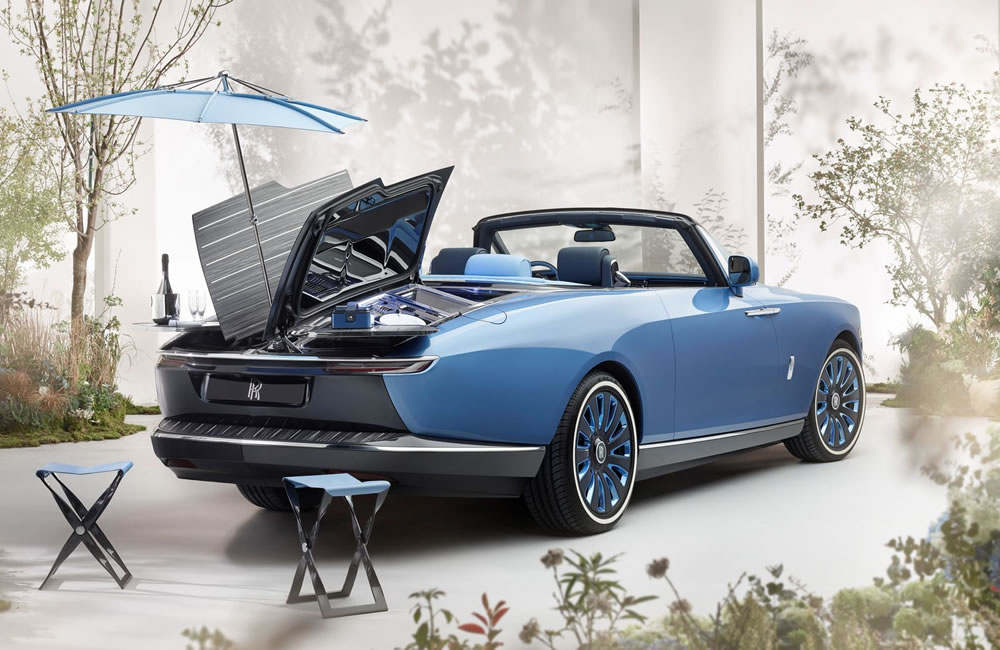
In working with these select few clients, Rolls-Royce delves into two worlds. The first – the intimately personal context of the client – their way of life and the experiences that have defined them. The second – the broader cultural context in which a Coachbuild car will exist. Here the marque explores the cultural nuances of the client, movements in architecture, couture, colour palettes, artistic tastes and so on.
The manual techniques of coachbuilding open up wider design opportunities. Preliminary design proposals are penned by hand, then a full-sized sculpture in clay is developed. Throughout this process, clients can continue to influence the direction. The clay sculpture is digitally remastered, from which the buck is created onto which aluminium sheets are hammer-formed by hand. Employing age-old individual hand skills and craft, a living canvas is created from metal – honing and optimising the aluminium body, creating a clarity of surface and continuation of line that is unable to be achieved by machine alone.
The process is similar to yacht building. A process of hand refinement is repeated almost endlessly, without the pressure of time. Slowly, vast sheets of metal transform into the sculptural representation of, in this case, Boat Tail. A pure form is created: uninterrupted by panel breaks, dramatic in its curvature, monolithic in scale and formed from one seemingly endless surface.
Rolls-Royce Boat Tail is a simply jaw droppingly stunning creation. A Rolls-Royce which blends sculpture with sometimes playful functionality. It draws on Rolls-Royce’s history, echoing a Boat Tail design but not explicitly mimicking it, delivering a thoroughly contemporary design.
At nearly 5.8m long, this is an elegant and graceful, yet bold and strong car. At the front, the iconic grille becomes an integral part, merging softly into the bodywork. In profile, nautical references are clear. The wrap-around windscreen as an example recalls the visor on motor launches, while the gentle rearward lean of the A-pillar and the tapered rear in contrast to the bolder front create an image that recalls a motor launch rising out of water under power.
The aft deck, a modern interpretation of the wooden rear decks of historical Boat Tails, incorporates large swathes of wood. Caleidolegno veneer is applied in a feat of Rolls-Royce engineering; the grey and black material which is typically housed in the interior, has been specially adapted to be used on the exterior, with no compromise to its beauty. The design style provides a nod to the typical wooden construction of yachts. Deep-set lamps establish a dramatically low reference point, evoking the dipped stern and proud bow of a motor launch under power and on plane.
The exterior of Rolls-Royce Boat Tail is swathed in a rich and complex tone of the client’s favourite colour – blue. The hue, with an overt nautical connotation, is subtle when in shadows but in sunlight, embedded metallic and crystal flakes bring a vibrant and energetic aura to the finish. The wheels are finished in bright blue, highly polished and clear coated to add to Boat Tail’s celebratory character.
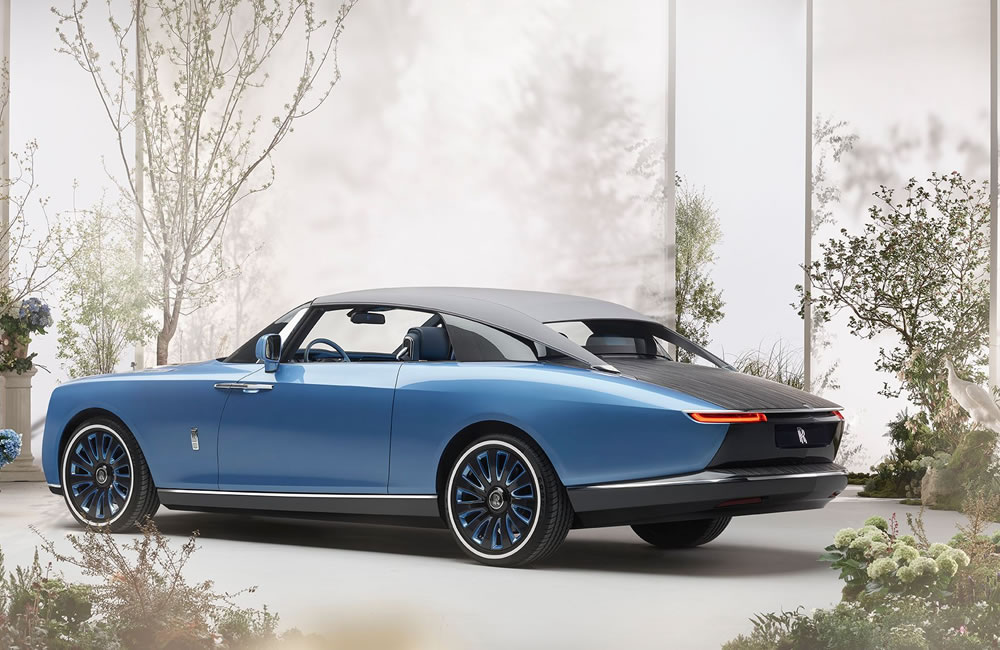
The interior leather also reflects the bonnet’s colour tone transition with the front seats swathed in the darker blue hue, recognising Boat Tail’s driver focused intent, while the rear seats are finished in the lighter tone.
The fascia has a modern aesthetic, features include unique BOVET 1822 timepieces specifically commissioned by the client for Boat Tail. As collectors of both the Swiss-based House of BOVET and Rolls-Royce, their vision was to create exquisite, ground-breaking timepieces for their Boat Tail.
In a three year collaboration, the two luxury brands came together to re-imagine Rolls-Royce’s iconic centrepiece, the dashboard clock. Two fine reversible timepieces, one for the lady and one for the gentleman, have been designed to be worn on the wrist, or, placed front and centre within Boat Tail’s fascia as the motor car’s clock. The instrument panel dials are adorned with a decorative technique named Guilloché, more commonly perfected in the workshops of fine jewellers and watchmakers. An elegant, thin rimmed two-tone steering wheel then bears the colours of the commission.
Possibly the most extraordinary aspect of this unique Rolls-Royce is what is housed within the rear deck of this remarkable vehicle. Rolls-Royce’s clients briefed the marque that “this car should mark a sense of occasion and serve that occasion like nothing else”. Rolls-Royce certainly embraced that brief, delivering a quite astonishing concept – at the press of a button, the deck opens in a sweeping butterfly gesture, to reveal an intricate ‘hosting suite’. Its complex movement was inspired by cantilever concepts explored by renowned architect Santiago Calatrava.
This hosting suite is hinged towards the centre line and the synchronised balletic opening movement reveals a treasure chest of moving parts that offer themselves to the host at a precise angle of 15 degrees. This subtle gesture of presentation reflects a quintessentially British expression of service.
The chest is appointed with the perfect accoutrements for a true Rolls-Royce al fresco dining experience; one side dedicated to aperitifs, the other, cuisine, complete with cutlery engraved with the name ‘Boat Tail’, made by Christofle in Paris.
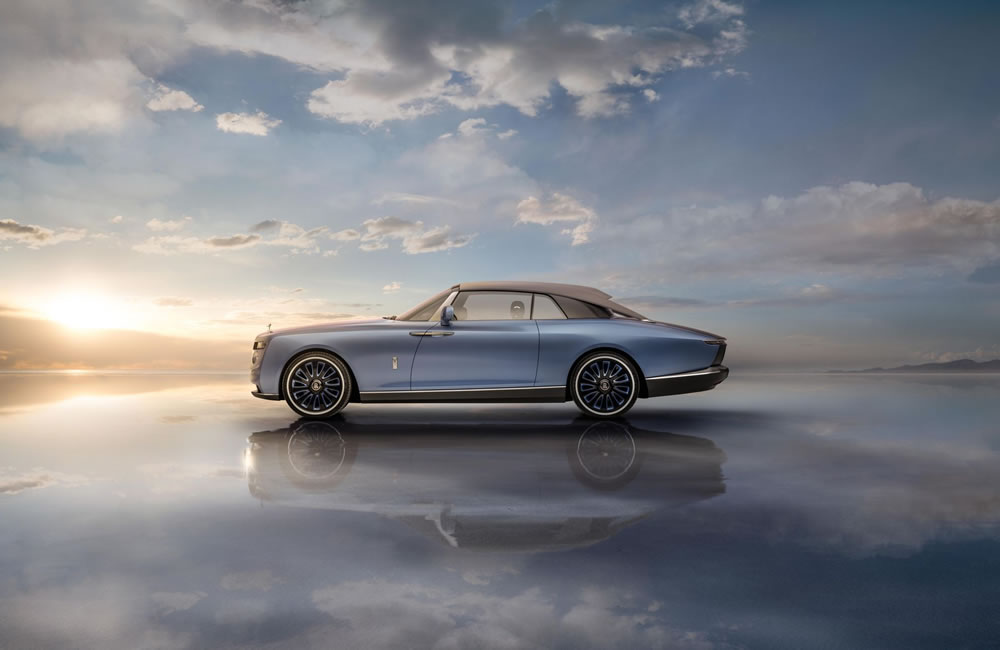
A double refrigerator has been developed to house the clients’ favourite vintages of Armand de Brignac champagne. Elegant cradles were created to stow the specific bottle size within the refrigerator, the surrounds are highly polished and colour matched to the bottle.
Cocktail tables, which elegantly rotate to mimic the offering of an attendant, open on either side of the hosting suite providing access to two highly contemporary minimalist stools, which are discretely stowed below. Designed by Rolls-Royce and created by Italian furniture maker Promemoria, the slim-line interlocking stools are formed from the same technical fibre found on the exterior of the car.
Attention to detail, the hallmark of any vehicle from Rolls-Royce, is evident in abundance with Boat Tail – indeed, the inside temperature of the hosting suite was a specific consideration. Boat Tail was created in anticipation of fair weather, so measures needed to be taken to ensure that heat absorption did not adversely affect the contents of the suite, which could include food, liquids and champagne. To that end, two fans are mounted in the lower section of the hosting suite to dissipate heat.
To ensure that Boat Tail’s hosting suite will fully satisfy the needs of its clients in any climate in which it may find itself, it has been rigorously tested in temperatures from 80 degrees Celsius to minus 20 degrees Celsius. Boat Tail underwent rigorous dynamic testing, including high speed analysis to ensure the contents of the rear hosting suite were sufficiently fastened and therefore silent under power.
Mr Müller-Ötvös sums up the significance of this latest release: “Boat Tail is the culmination of collaboration, ambition, endeavour, and time. It was born from a desire to celebrate success and create a lasting legacy. In its remarkable realisation, Rolls-Royce Boat Tail forges a pivotal moment in our marque’s history and in the contemporary luxury landscape.”
The price tag for the Rolls-Royce Boat Tail is rumoured to be in excess of $25 million, although these details have been kept private by the company.
A Rolls-Royce is, and has always been, luxury like no other. Whilst over 5,000 cars may be produced each year, each one is still crafted with the same passion and dedication for perfection with which Henry Royce and Charles Rolls founded their small car company all those many years ago.
With Boat Tail, Rolls-Royce opens the latest chapter in its extraordinary journey, the Coachbuild programme a contemporary rebirth of its coachbuilding heritage, setting new standards for luxury cars. The Boat Tail is a car of beauty, elegance, refinement and sophistication, coupled with an injection of fun and joy. It is a marvel to see. Rolls-Royce continues to transcend the luxury automobile industry setting new standards for the wider luxury industry as a global luxury icon.












